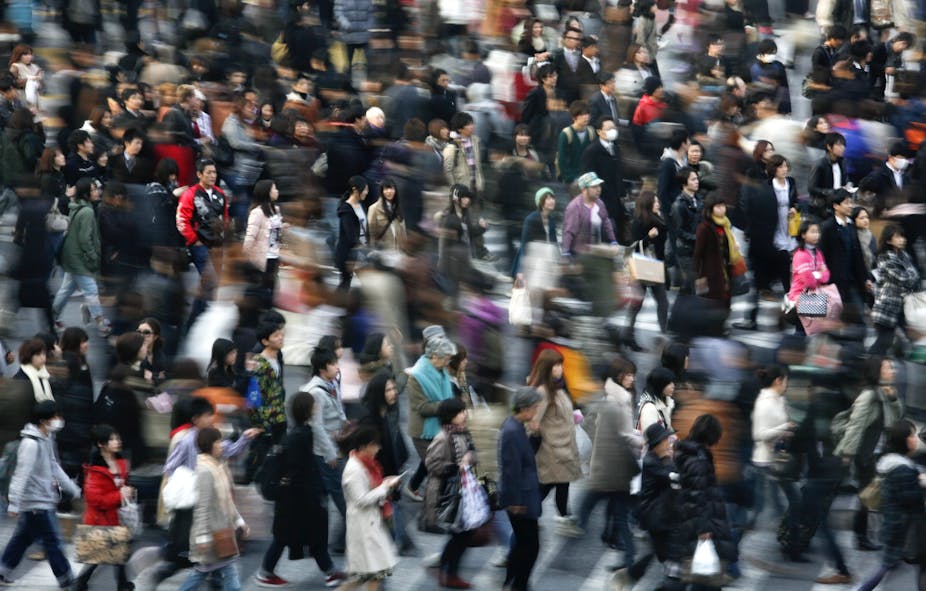Japan might be the third largest economy in the world, but the past 20 years have seen its GDP growth rate fall behind that of its economic rivals, the US and UK.
The outlook appears bleak. Recently, Japan halved its second-quarter growth estimate, raising fears of a recession. Morever, Japan’s exporters could face more pressure after the US Federal Reserve announced a third round of quantitative easing, which could drive down the US dollar against the yen.
Pressure to deal with the country’s darkening economic outlook has fallen to the Japanese government (whose deficit financing bill probably won’t make it through the opposition-ruled upper house).
Meanwhile, Japan’s central bank has vowed to maintain its monetary easing policy.
Ippei Fujiwara from the Australian National University examines the long-term economic health of the nation and suggests societal ageing and a lack of technological growth could be to blame for the country’s falling GDP growth rate.
Japan is currently the third largest economy in the world, yet you call the last two decades in Japan’s economic history the “lost decades”. Why?
If we compare the path of Japan’s per capita GDP to that of the US or the UK or France, we can see Japan reached almost the equivalent level of the US and the aforementioned countries around 1990. Before that, GDP growth rate was around 9.4% until 1970 and 3.4% until 1980. Catch-up to these countries ended around 1990. Japan’s lost two decades should not be recognised as the drop of GDP growth rate by 3% after 1990. Rather, the issue is why per capita GDP growth after the catching up has been relatively lower than other advanced economies. After 2000, Japan’s per capita GDP growth rate was under 0.9%, while other major countries on average were 1.4-1.5%. The problem to be investigated is a milder one: why the per capita GDP growth rate has been lower by about 0.5% than in other advanced economies.
How do you explain the falling GDP growth rate?
Japan’s growth rate is not the highest per capita, but if you compare Japan’s GDP growth rate to the working age population, surprisingly Japan’s growth rate is higher than that of any other industrialised economy in 2000-2010. Production should be constrained by the working age population. This means we can explain falling GDP growth rate by examining societal ageing.
Interestingly, there also appears to be a link between land price and the working population, which is explained by this inverse dependency ratio graph where the pink line is real land price and the black line is the working age population.
The peaks, as you can see, tend to correspond.

Where should Japan look to maintain its economic status?
The distinction between the GDP and GNP is important in an ageing society. While GDP is gross domestic product, GNP refers to gross national product and includes international income from abroad. Japan has the biggest net foreign asset base in the world. It sends a lot overseas — more than it purchases. Theoretically, if you are exporting more, you have greater foreign currency. The way to make profit is then to keep foreign earnings overseas, which means you can get interest repayments. That’s the basic idea of this concept, and Japan has been receiving positive financial income from this. As per capita GDP falls with societal ageing, it’s becoming more important for Japan to maintain GNP to in turn maintain living standards.
But recent studies show that the interest Japan earns from net foreign assets is, in actuality, very small – Japan appears to be inefficient in its investments. This is certainly a place in which Japan needs to improve. At the same time, there’s a huge demand for [technological] industry in terms of supporting the ageing population with innovative goods and devices. If we can create new goods and services for elderly people, Japan can be the leading country in the “greyer” world. This will result in an increase in the productivity and therefore raise not only GDP but also living standards.
The Bank of Japan has announced a 1% inflation target in an attempt to increase consumer demand. What role has its policy played over the last 20 years in establishing the current economic climate?
People tend to blame the BOJ for not making inflation expectation high enough, especially compared to the United States where, even after the Lehman crisis, inflation expectation was kept around 2%. In Japan, inflation expectation can often be negative because the current inflation rate is negative. There’s the argument that should the Bank of Japan have reduced nominal interest rates in the 1990s, then we could have avoided deflation. This ignores the idea that monetary policy is always implemented in periods of uncertainty. In fact, my research shows that optimum monetary policy undertaken in this period of uncertainty was not far off what had already been conducted in Japan.
The asset bubble of the 1980s is similar in that people often talk about the need of the central bank to do something. But from the point of view of the standard theory, asset prices were growing thanks to technological progress. Under such circumstances, tightening monetary conditions is like tightening demand, so in this situation you are increasing production capacity but reducing demand. It is not still clear whether central bank can act preemptively to avoid bubble under uncertainty.

